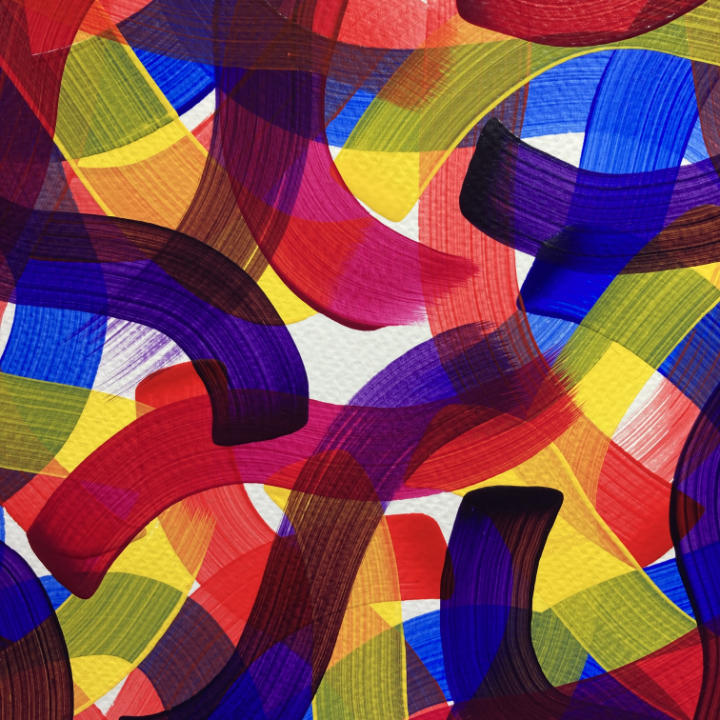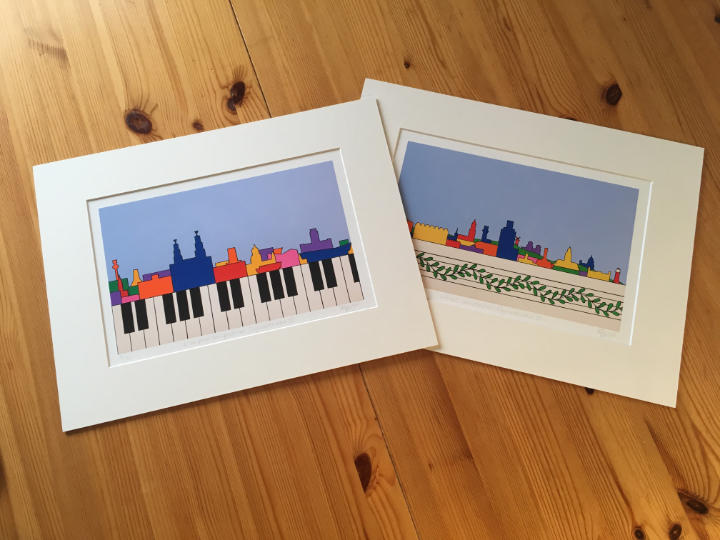Ali Barker is a contemporary abstract artist based in Liverpool. She was the winner of Merseytravel’s ‘Art on the Network’ competition in 2011, with two of her skyline murals of Liverpool and Wirral permanently installed on the panelling at either end of the Queensway (Birkenhead) Tunnel. She held her first solo show ‘Four-Dimensional Colour’ in 2016, and completed her MA in Fine Art in 2019.

Ali works with a fixed palette of twelve colours to represent the colours she perceives through her experiences of the phenomenon of sound-colour synaesthesia – when listening to music, she perceives each note of the musical scale as a specific colour. She is inspired and motivated by these experiences, drawing upon them and her musical background (she plays the violin and the viola) to create her paintings. Starting from her perceptions whilst listening to specific pieces and/or from the written music, her process translates melodies and excerpts into colourful paintings, ranging from gestural works to geometric patterns.
Hi Ali, thanks so much for taking the time to speak to us, firstly could you tell us a little bit about your journey as an artist?
Yes, of course. My artistic journey is a little unconventional, as I didn’t study art at school – I had to choose either art or music to fit in with three science subjects, so I chose music! My first degree and career were science-based, but, in my spare time, I continued to make artwork and visit galleries and exhibitions, as well as play in local orchestras.
In 2009 I decided to study A-level art part-time, which is when I started to explore the connections between music and art. A few years later, after 20 years in my previous career, I left that behind to focus on my artwork. I threw myself into studying Foundation Art and Design for a year, which enabled me to experiment with connecting my synaesthesia, my musical background, and my artwork.
After a couple of years of developing my practice on my own, I studied part-time for a practice-based MA in Fine Art, which provided a framework to understand what is most important to me in my practice: my personal experiences of synaesthesia and of playing and listening to music, and the processes I use to create my work.

Your work is closely tied to your experience of synaesthesia when listening to music. How do the sounds translate into colours and shapes, is it quite literal to you or do you get something different from each different piece of music?
The colours I perceive are always the same for specific notes of the musical scale and they are the starting point for my artworks. What I ‘see’ is difficult to describe in words (many synaesthetes find it difficult to describe their experiences) but could be described as fleeting perceptions of bright colours in my mind’s eye. I don’t consider my synaesthesia to be a ‘condition’, rather an ‘addition’ to my everyday life.
The patterns and shapes in my work are not literal reproductions of my experiences; I draw upon my musical background and use the specific colours I perceive as the stimulus for my artworks in response to specific pieces of music. I am often influenced by the music I am rehearsing/performing, as well as the wide range of music I listen to, or music chosen by a client for a commission.
The process I employ to develop and create the work tends to involve two ways of working, which I refer to as expressive and geometric. The expressive works are spontaneous, involving listening to the music and putting down paint in the colours perceived, layering the different coloured marks and/or manipulating the paint on the surface in response to the shape or feel of the music.
In contrast, the geometric works can take weeks or months to develop through drawings and sketches before being executed as a final painting. These translational paintings use the colours I perceive in geometric patterns representing excerpts or melodies from the written music. Recently my geometric works (such as the two Mahler paintings in my Cass Art exhibition) have been exploring the visual interweaving of two or more musical themes.

You have said your work is very much process-driven, but are there any artists or movements that you have found to be an influence on your art practice?
It was a painting by Wassily Kandinsky (also believed to have been a synaesthete) that first sparked my interest in researching the connections between music and art: he painted Impression III (Concert) in 1911 as his response to listening to a concert of new music by the composer Arnold Schoenberg. It was this research during my A-level studies which helped me to understand that my experiences were synaesthesia, and to start to put down the colours I perceive in paint and define my musical colour scale.
I think in the early stages of developing my practice, many early 20th century artists influenced my work, including Kandinsky, Paul Klee (also a violinist), and the Australian artist Roy de Maistre (who experimented with translating entire pieces of music into colour from 1919 onwards). Thinking about more contemporary artists, Bridget Riley’s sequences of coloured stripes, and the large, colourful paintings of the late John Hoyland (also born in Sheffield!) have more generally influenced my paintings. Gerhard Richter’s geometric patterns of coloured squares, as well as his manipulation of paint on a surface, have also influenced both of my ways of working – similarly, I don’t feel I want to restrict myself to only working in one way, I tend to switch between the two for periods of time.

What sorts of materials would you say are integral to your work?
I use specific paint colours, mostly straight from the tube to keep them clean and bright – my perceptions of colour are bright, so I try to reproduce the colours as closely as possible and limit using the duller colours of mixed paint. One colour I perceive I would describe as a shimmering red-brown, so after much experimentation, I settled on using copper paint to represent that note. I mainly use Liquitex paints, as they can provide me with the range of specific colours I need – my go-to paint is Soft Body, but I have also used their Spray Paint, Acrylic Ink, and Acrylic Gouache, as well as a variety of their Professional mediums to create the consistency and translucency/opacity I want for different pieces. When working on canvas, sturdy stretcher bars are essential – the Cass Art stretcher bars work well for me, come in a wide range of sizes, are easy to put together and are strong enough not to warp, which is vital for my geometric work!

Your murals for the Art on the Network competition are an iconic part of the Merseyside landscape. What is it like to have your work as a permanent public art installation?
I was a bit overwhelmed when I won the competition! It was during my part-time A-level studies, before I’d taken the plunge to leave my previous career. My digital designs were used by the company who made all the panels for the tunnel refurbishment project; they screen-printed and fired the colours in vitreous enamel onto the stainless-steel supports. They were installed over ten years ago but should last a long time. My original Liverpool Composition and Wirral Composition paintings are, understandably, not for sale, but are still available as limited-edition prints. I live on the Liverpool side of the Mersey, but have several connections to Wirral, particularly through music, so I get to travel past my artwork quite regularly!
Finally, what is in store for you for the rest of 2022? Anything you can let us in on?
In October, I will be Artist in Residence for the Wirral Arts Festival 2022. I’ll be working with an orchestra and some other musical groups who are performing at the festival, making artwork in response to some of the pieces they plan to play in their concerts and then displaying the finished paintings at the concerts. In fact, some of the works on paper in my current exhibition at Cass Art Liverpool were made during last year’s festival.
Otherwise, I am content to be mostly developing new work this year, reflecting on and continuing from ideas that arose from my six-week solo exhibition and residency project in an artist-led space in Liverpool last summer. I am also starting to look towards some potential exhibition opportunities in 2023 and 2024. There are always group exhibitions to apply for throughout the year, so I’ll see what else comes up!
FEELING INSPIRED?
You can find more of Ali Barker's work on her website and be sure to follow her on sociial media too - @alibarkerart
